Your cart is currently empty!
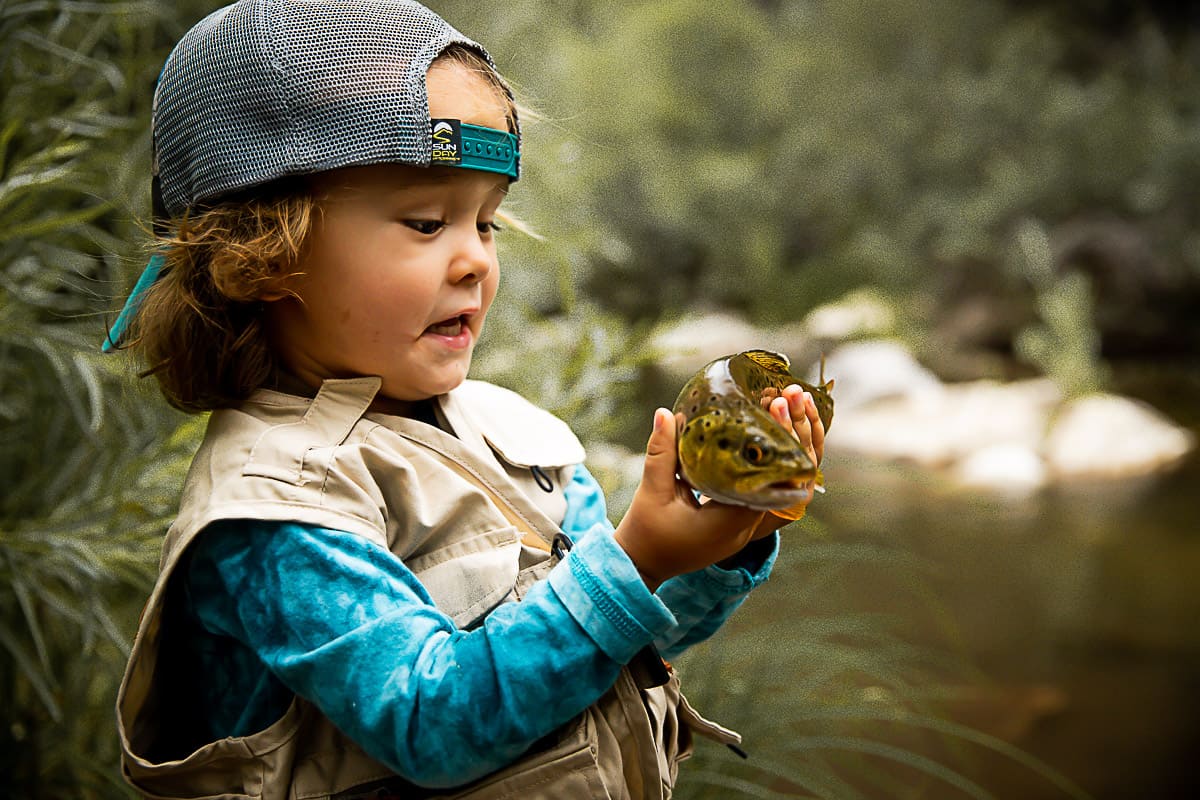
Fly Fishing 101: Fly Fishing Basics for Kids
Fly fishing is a fun and enjoyable outdoor activity for the entire family. Today, nurse, veteran, and New Mexico mom of two, Lea Reynolds is here with an overview all about the basics on fly fishing with kids. She’s sharing great advice for how to plan a fly fishing outing with kids, how to choose the right fly, favorite kid-friendly fly fishing gear, the basics of casting and landing a fish, plus, a great video on how to tie fly fishing knots.
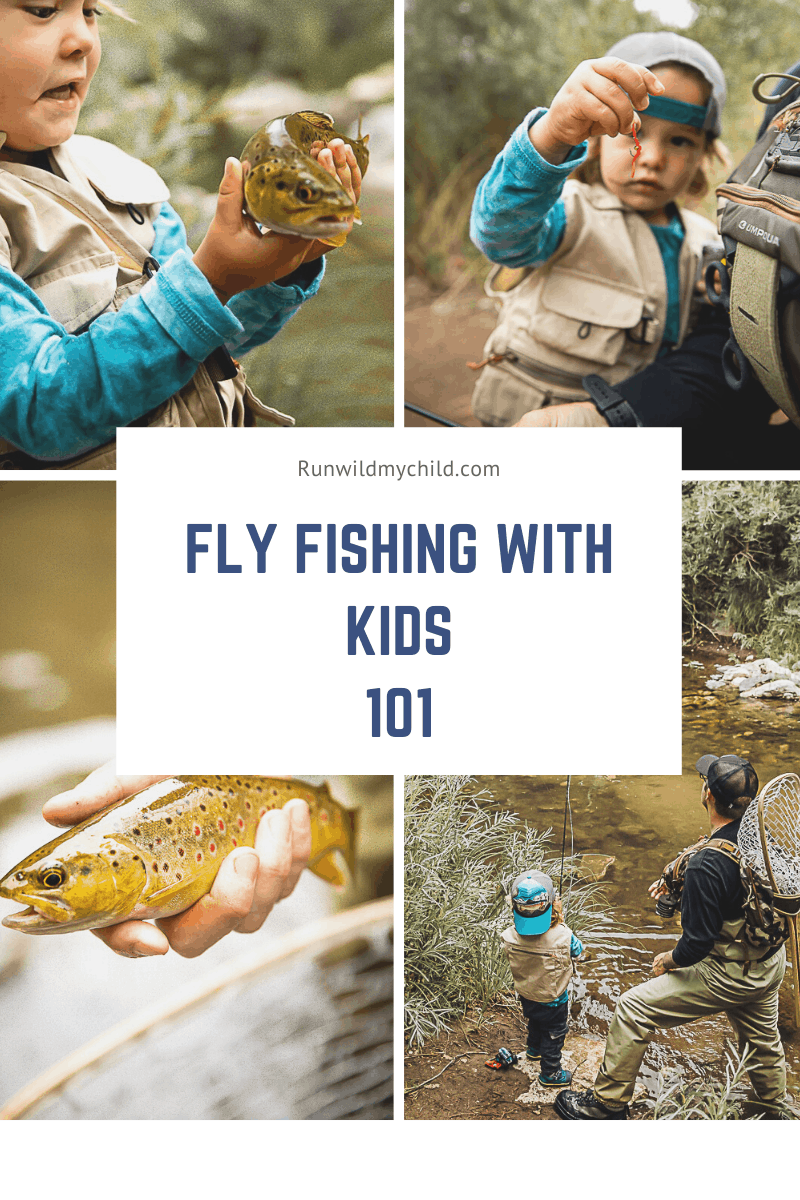 Fly fishing with kids
Fly fishing with kids
Fly fishing has become very popular over the last few years. It’s a beautiful and peaceful outdoor activity, but it can be intimidating at first. Beginner fly fishermen (and fisherwomen) are sometimes overwhelmed by the variety, abundance, and price of fly fishing gear. It’s hard to know what flies will work best in your area, how to tie knots and where to go fish.
Today, I am here to help answer all these questions and get you started fly fishing with your kids. I’m here to teach you the basics of fly fishing with kids, from gear to casting and reeling in that slithering fish. This post will cover 3 categories: (1) planning your fishing outing; (2) kid-friendly fly fishing gear; and (3) the basics of fly fishing.
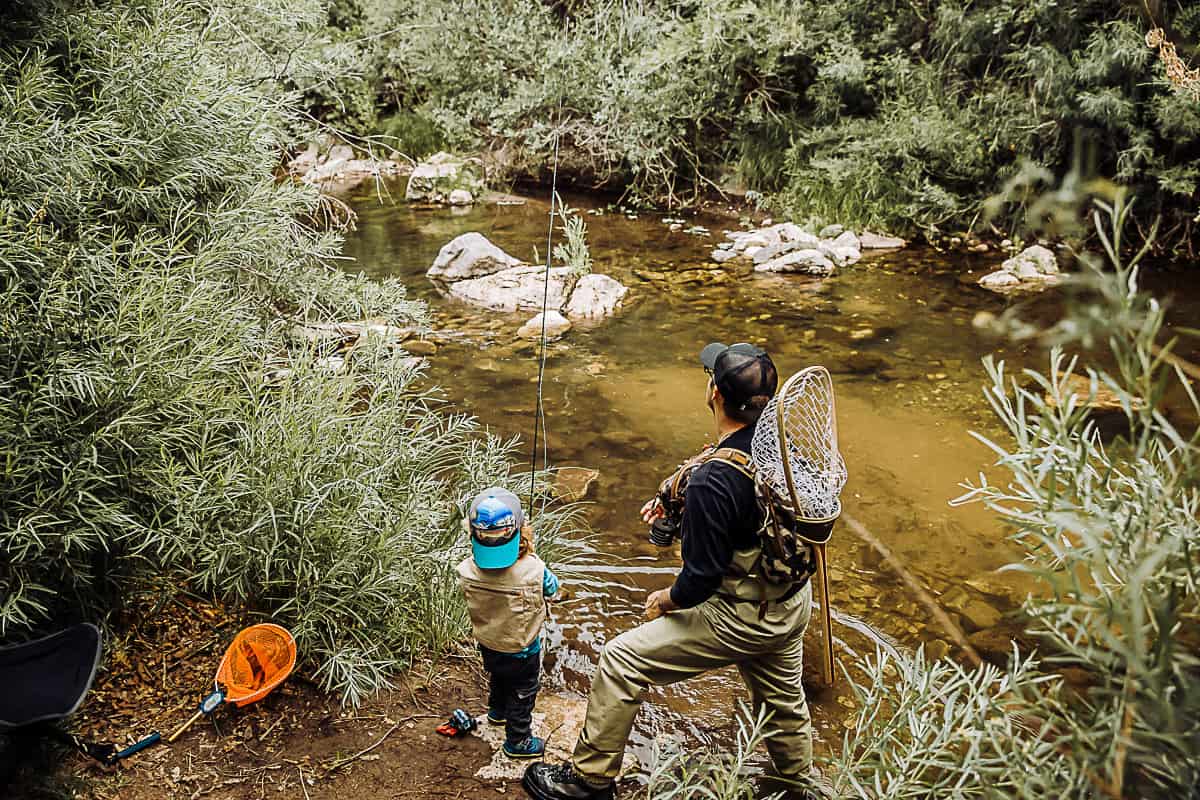
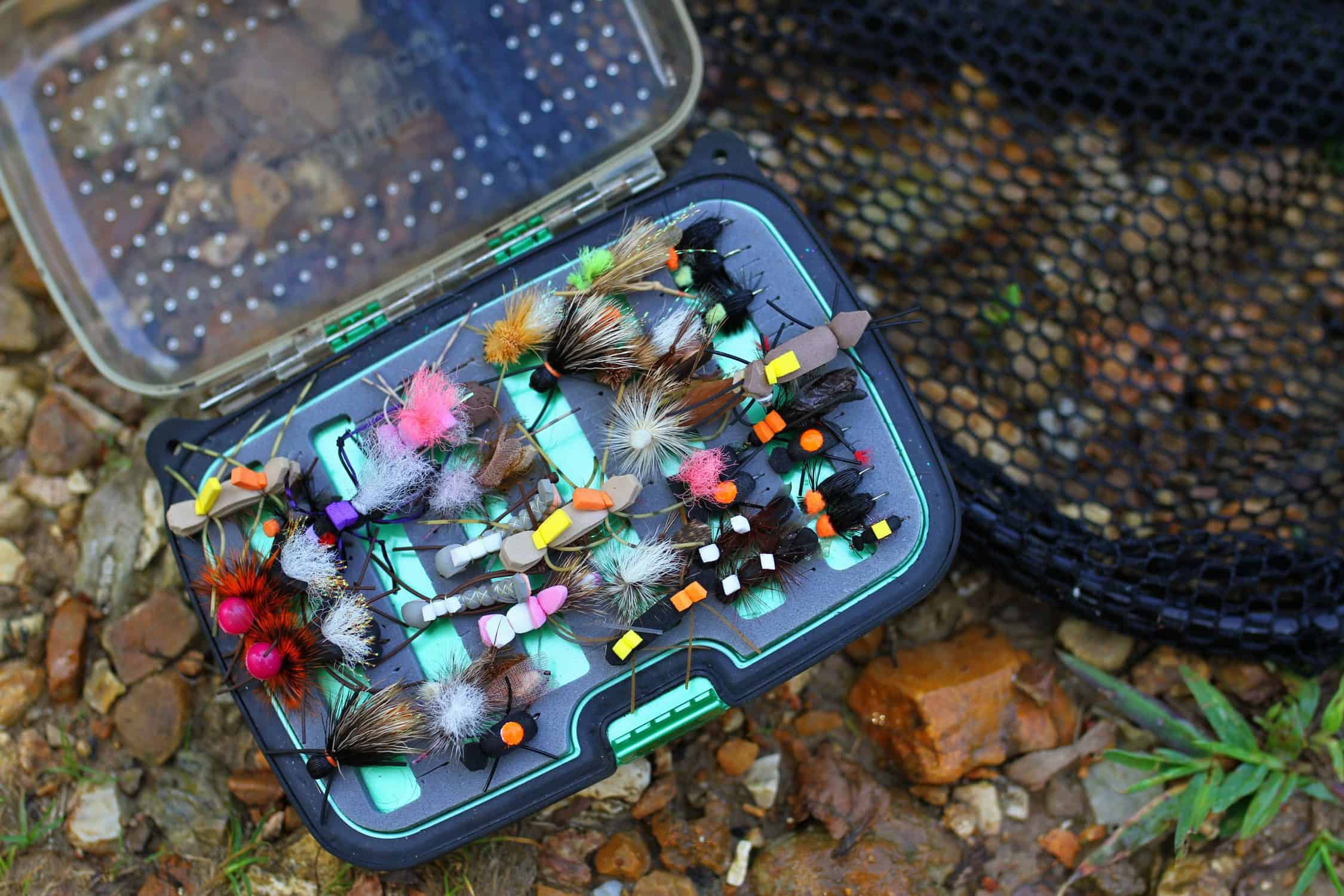
Planning your fly fishing outing
Before you ever set foot in the water, there are a few things you’ll need (and need to know) so that you can plan your fly fishing outing. A little research and knowledge about the activity and your local area will go a long way to making your fly fishing adventure fun and successful. Most of the information below can be found online (check your local conservation department’s website) or from the helpful folks at your local fly fishing shop.
1. Get a fishing license
It all starts with the basics. If you’re going to fish, you need a fishing license. Do some basic research on what’s required to fish on your state’s website regarding fishing rules and regulations (fish and game). Most states don’t require a fishing license for kids under a certain age, but it’s important to make sure. But if you’ll also be fishing (or even just helping your kids cast and reel in fish), you’ll need to have one.
2. Check your conservation department website
Conservation department websites are also a good place to find helpful information on a wide variety of fishing-related things. On your local fish and game website, there will be rules and regulations governing fishing and lots of helpful information, such as:
- Fish limit (number and size)
- What types of hooks you can use
- What type of bait you can use
- Whether we can keep the fish or we have to catch & release it
- Designated fishing areas
- Resources (casting videos, fly tying basics, etc.)
- Fishing ethics
- Fishing tips
- Recipes (and how to clean and prepare fish for eating)
- Fishing events (classes, meet-ups, lessons, etc.)
It’s super important to make sure you follow these rules (and teach kids to do the same) to protect our wildlife population and the sport of fishing. This is a great topic to educate our kids so they learn to respect the wild and the rules our conservation departments and forest services have set in place. Lead by example and be a role model for your future little fishermen.
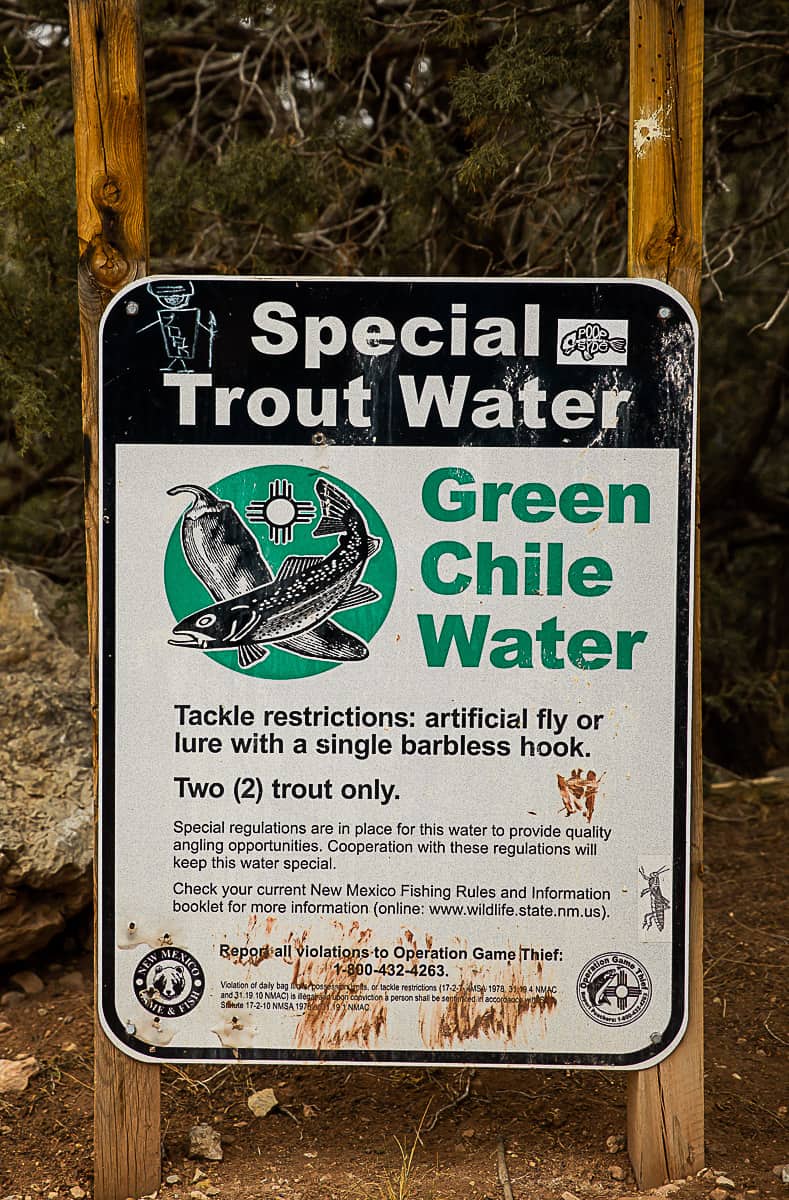
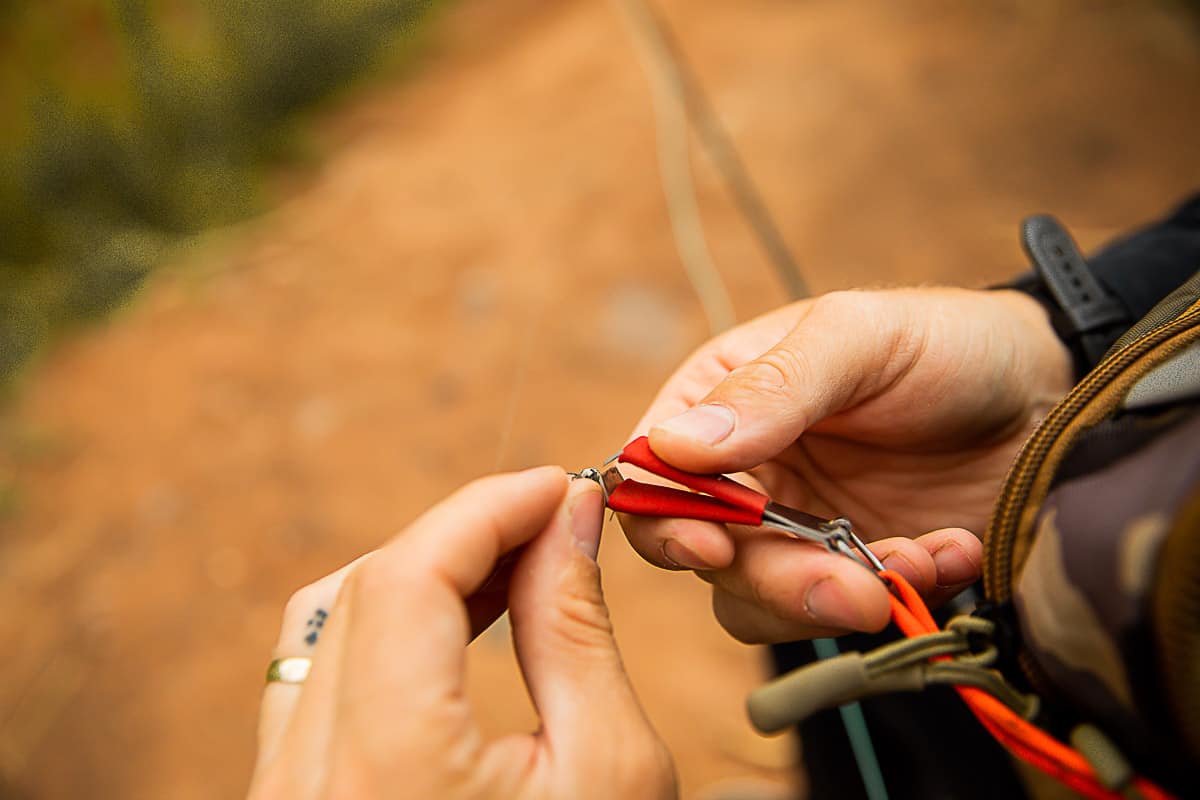
Fly fishing gear for kids
Choosing the right fly fishing gear for kids can be intimidating (and expensive). However, for the most part, kids learning how to fly fish can usually use their parents’ gear. With the exception of waders/boots and clothing, there aren’t a lot of items that need to be specially geared towards children. That being said, giving a child their own fishing gear that’s their size and they’re proud of is a great way to get kids interested in going fishing. This post will cover the basic gear you need to get started fly fishing with kids.
Kid-friendly fly fishing gear
Again, starting out can be a bit intimidating but if you head to your local outdoor or fishing store, experts can help you choose the best equipment for your skill level. Here are a few of our favorite recommendations for kid-friendly fly fishing gear.
- Fly rod and reel
- Fishing net
- Water shoes or waders
- Hat
- Sunglasses (for eye protection and polarized to help spot fish)
- Sunscreen
- Bug spray
- Fly pack
- fly box
- flies (see below)
- pliers
- nippers
- floatant
- tippet
- strike indicators
- Life jacket
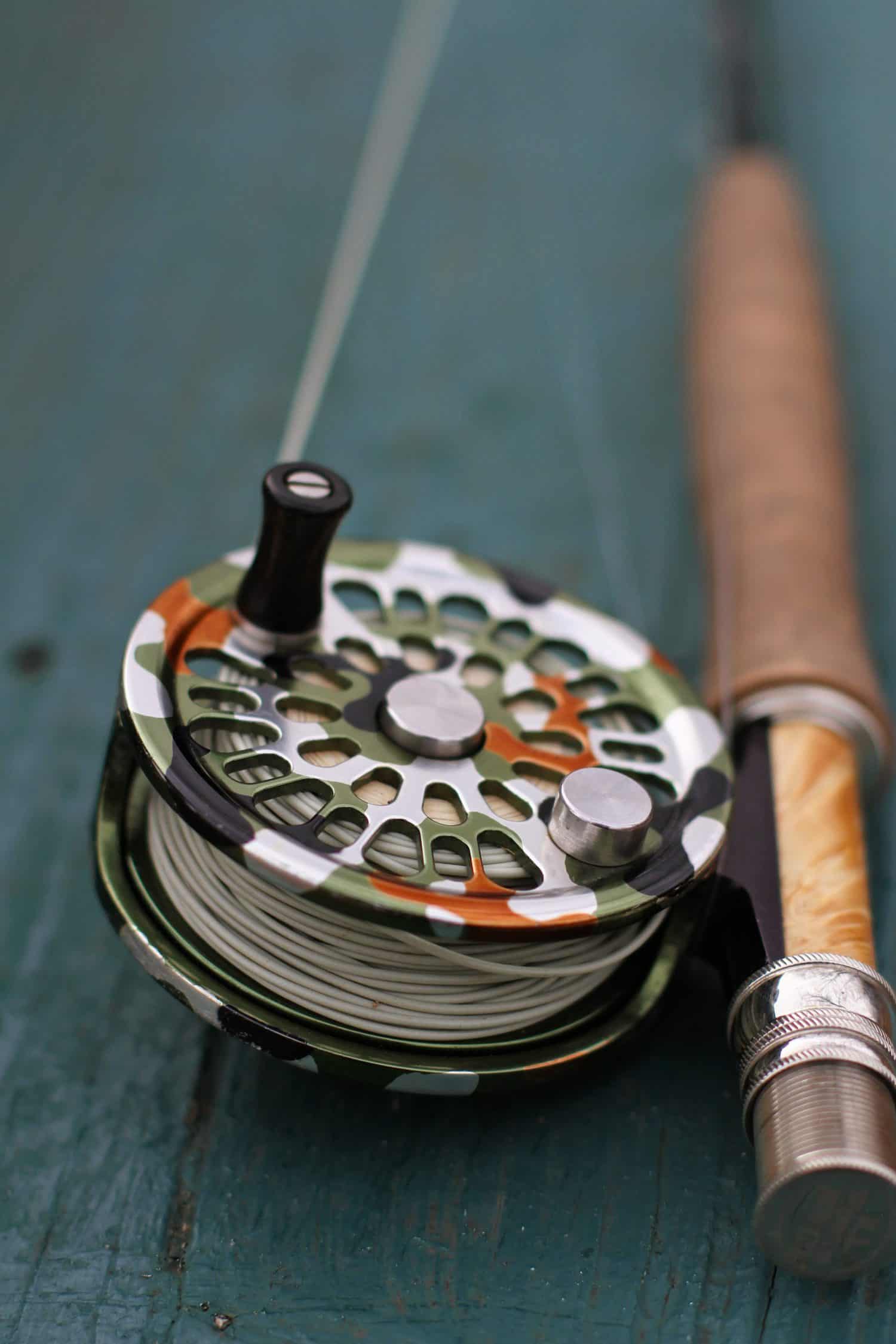
How to fly fish with kids
With fly fishing, it’s all about the movement of the fly or bait. We don’t sit in a chair while waiting for a strike on a distant bobber. There’s not a lot of downtime. It’s constant movement and angles and a million different shots. It’s trial and error and retrial.
The art of fly fishing is making a successful cast, matching the water speed with a good drift, and mimicking your fly of choice on the water. It’s part art, part science, and part sport. This is what makes fly fishing so much fun! We are constantly moving around the river or riverbank, casting into different areas, and waiting for the bite! It’s non-stop, which makes it so much fun for kids (and adults), as you’re constantly on the move and actively fishing.
The basics of casting
The easiest way to picture a successful cast begins with an image of a clock. Consider 12 o’clock as right above your head. The fly rod is taken back to the 2 o’clock position in a “brisk” backcast, then take a slight pause as the fly line straightens out behind you. Next, make a “brisk” forward cast stopping at the 10 o’clock position to cast the line out in front of you. During the cast, it is important to keep the tip of the rod up.
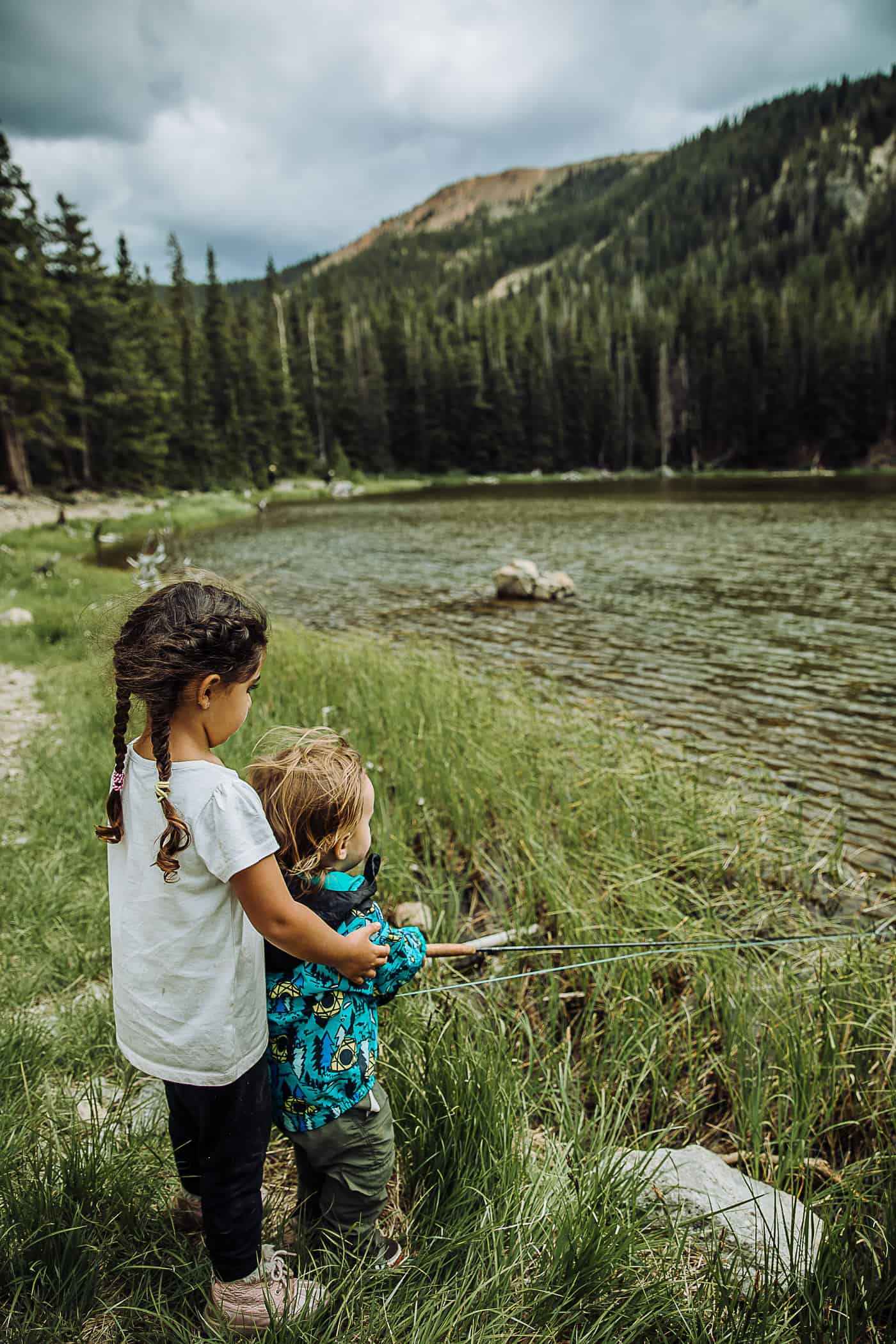
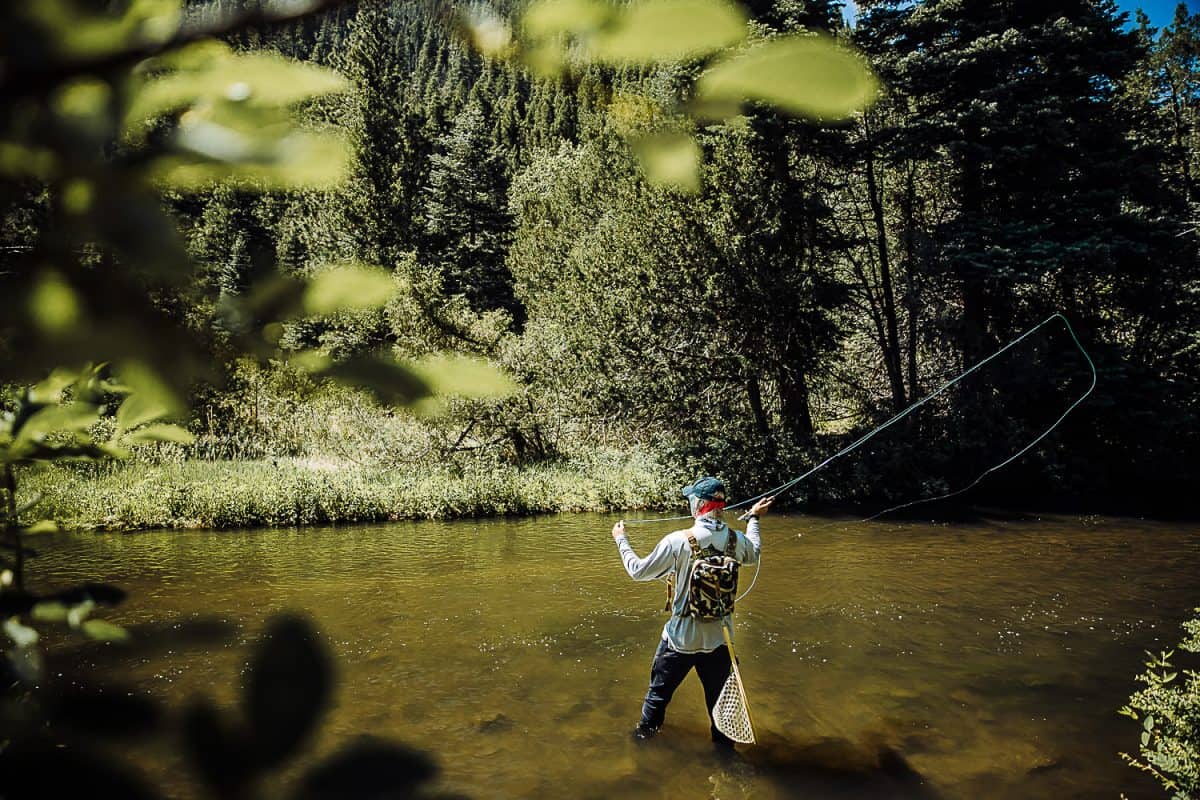
How to choose the right fly
Fly fishing is different than “normal” fishing. Instead of using live bait, fly fishing uses artificial flies that replicate actual insects that fish eat in their environment. Knowing what’s local, what’s in season, and what fish will eat requires some research.
There are flies, worms, eggs, and even small fish replicas that we use in fly fishing. Several types of flies can be used year-round, while others are more season-specific. I recommend heading to your local fly shop or sporting goods store to purchase the specific flies you’ll need in your area. A fly shop will help you get to know what’s working well at the time and can make some recommendations based on where you’ll be fishing.
Sometimes, figuring out what the fish are eating is as easy as looking along the river banks or under rocks. You might be surprised to learn how easy it is to determine what bugs, insects, and larvae are active at the time, and find a fly that replicates what’s hatching or abundant.
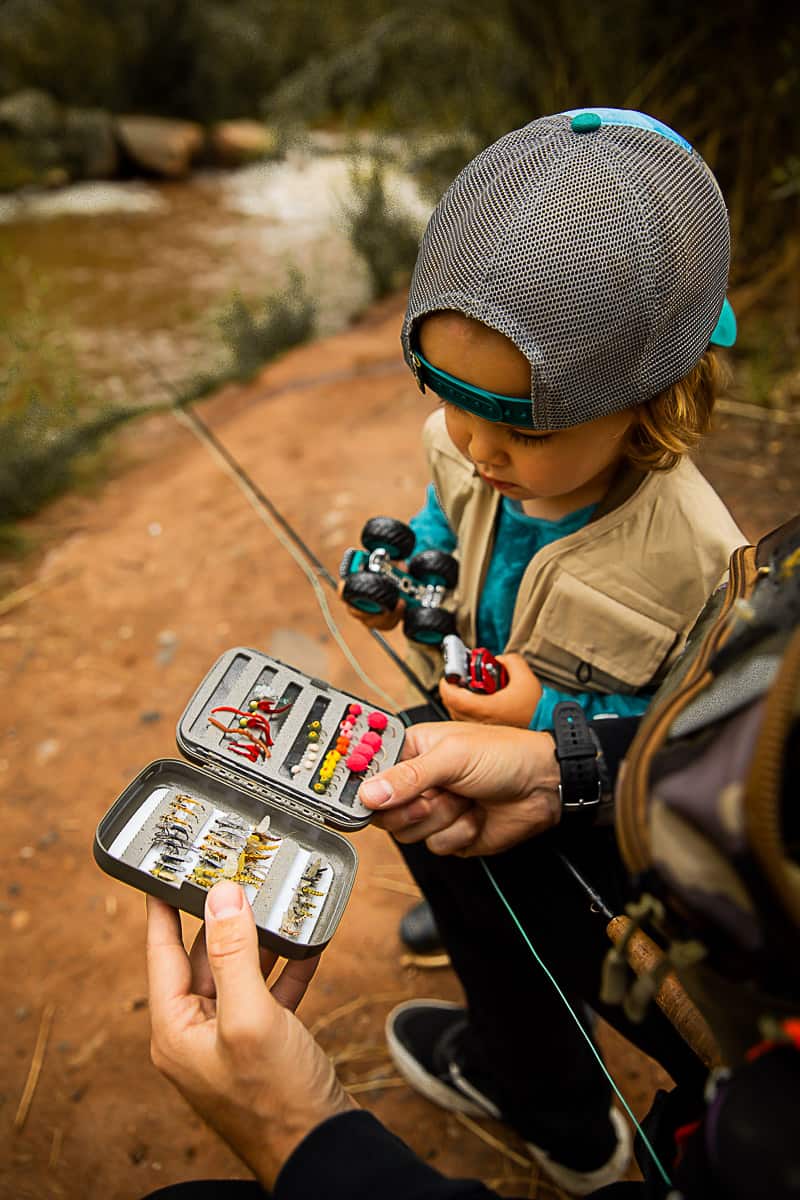

The science behind choosing the fly
Another great way to learn what type of fliy to use is to go out into the river, pick up a big rock, and look on the bottom of it for insects. This is the perfect way to see what insects are in season (aka “hatching”) and what the fish are eating. Here, my husband grabbed a rock from the river we were fishing and underneath it, a stonefly appeared!
This is such a fun part of fishing to teach our kids! It’s about observation and discovery. It’s about getting to know your area and doing a little science experiment to figure out what’s working. Our little guy loves his dad’s “bug box” as he calls it. He picks the flies up individually and asks bug/insect each one is and then we try to find a live specimen and match them up.
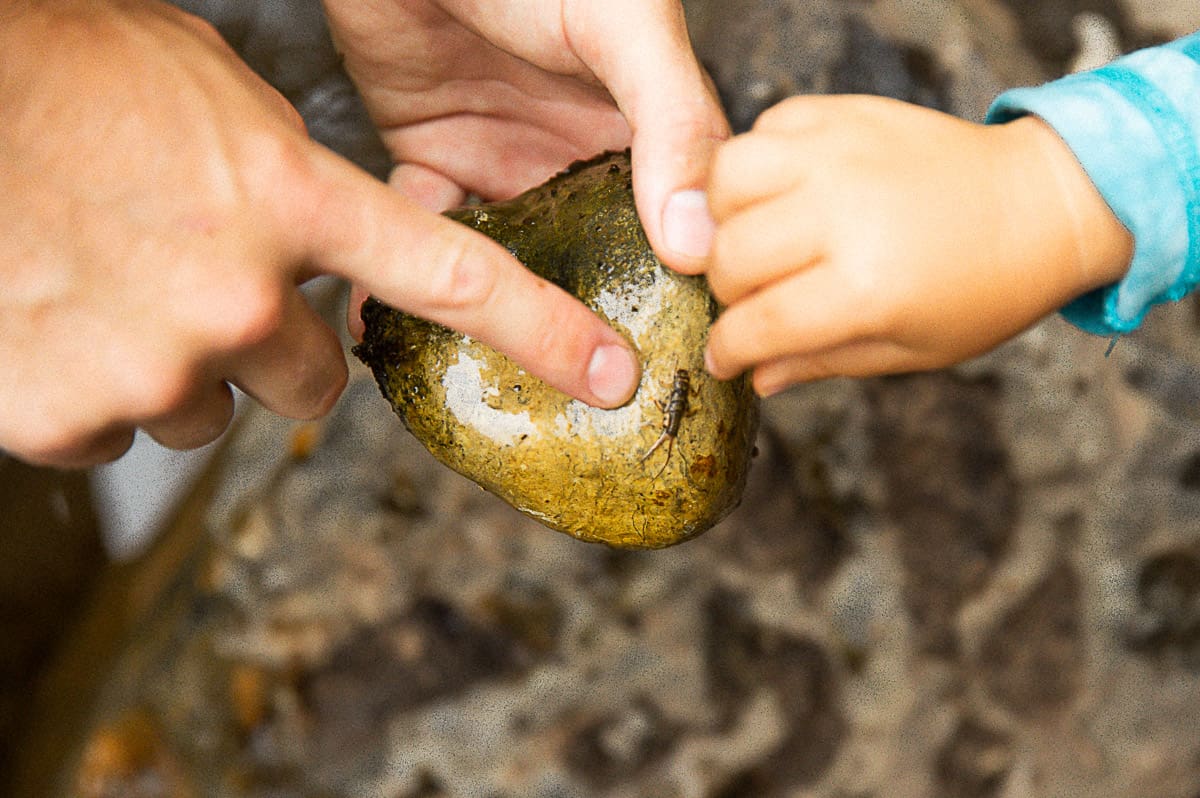
Different types of flies for fly fishing
- Dry flies (parachute adams, elk hair caddis, blue wing olive, stimulator)
- Nymphs (hare’s ear, pheasant tail, prince nymph)
- Streamers (woolly bugger, mickey finn, muddler minnow)
- Wet flies
- Eggs
- Worms
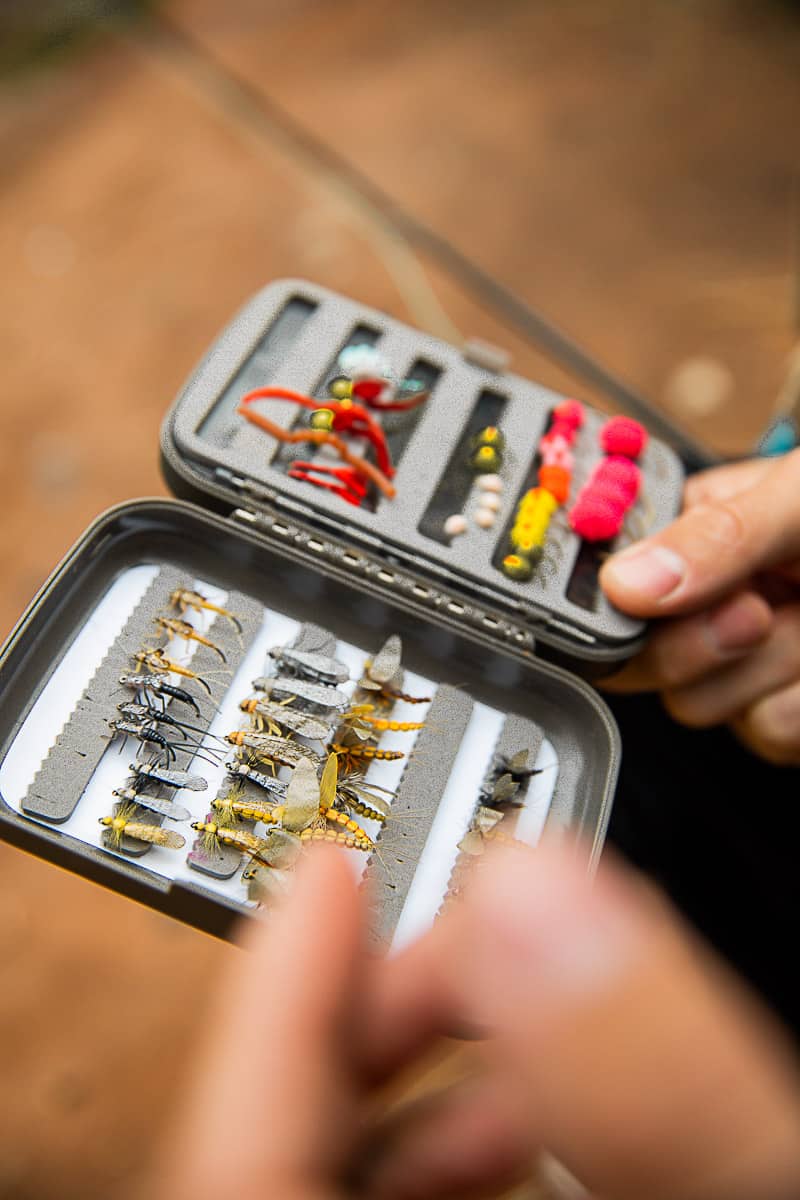
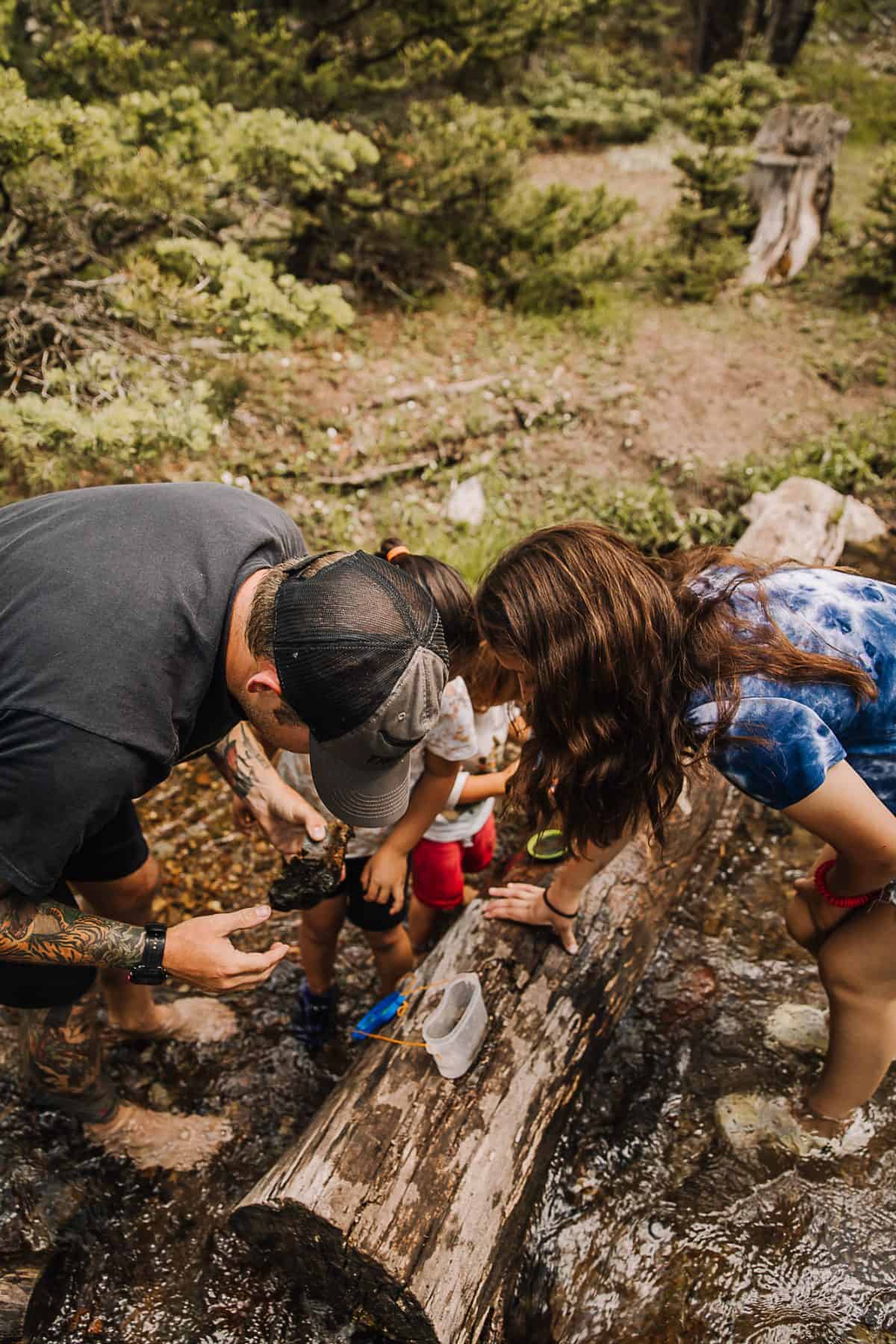
Sink or swim
It’s important to know which flies are designed to float on the surface of the water and which flies should sink. Floating flies are mimicking a flying insect landing on the water’s surface. This requires us to apply floatant, which aids in the fly’s ability to remain on the surface of the water.
Your first goal when casting is having the fly land softly on top of the water, similar to how an insect would land. Then, the line and fly both drift at the same speed the water is flowing. If your fly line drifts faster than your fly, you may need to “mend” your line, which means gently whipping the line back a bit to allow the fly to drift naturally (without the fly line pulling it or scaring the fish off). During the drift, a nearby fish may look to the surface and see your fly. Suddenly, it begins to rise believing that a real insect is up for grabs and takes a bite!
If you are using a worm or even an egg pattern, you’ll want to allow this type of bait to sink beneath the surface. Then you allow the current to move your fly down the stream, hopefully right in front of a fish waiting for it! You may want to put a strike indicator on your child’s line so they can tell if/when they get a bite (this is kind of like a bobber). You can never go wrong using a worm or egg pattern, since most popular fishing spots for kids are fished using these types of bait.

How to tie on your flies
Where to cast
Fish are smart when it comes to where they hang out in the water while waiting for their food. Look for these areas to cast your fly.
- Shallow/shady pockets of water
- Where you see bubbles (oxygen=fish!)
- Sides of running water
- In front of rocks with water running down like a small waterfall
- Behind rocks or logs (fresh like a break from fighting the current)
Bites! How to reel in a fish
Now we’re ready for the fun part! When you feel that tug on your line or see your strike indicator submerge underwater, you know you have your catch! Now it’s time to hood and land your fish! Easier said than done.
To get a good hook set, quickly lift up on your fly rod to create tension, thus “setting the hook.” Maintain tension on the line with one hand, while you use the other to reel in your line. During this time, you can also use the drag setting on your reel to make things easier. A second option is to simply pull the line in without using the reel. Hold the line tight with the hand holding the rod and let it slip through your fingers as you pull the line with the other hand.
When you get the fish close, grab your net and position it downstream from your fish. Slowly pull or reel the fish in towards it and you got your catch! Gently remove the hook and remember to keep the fish wet at all times. As long as it’s not super hot, you can lift it out of the water for a super quick photo and then right back in. Don’t forget to enjoy the moment!

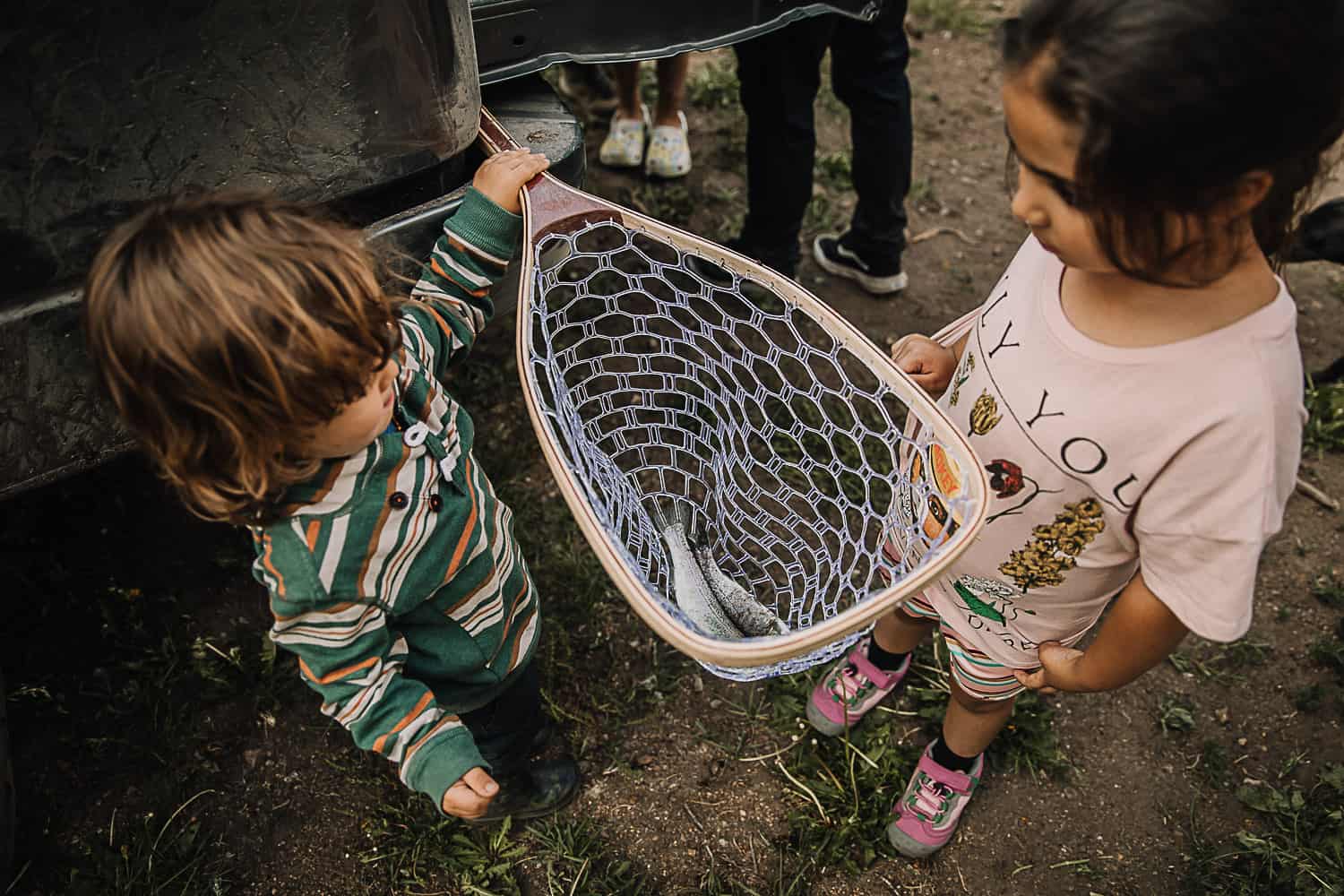
Releasing the fish
There is a proper way to release fish back into the water if you decide not to keep it for food. When you take fish out of the river to admire their beauty and take a photo, it’s important to remember time is critical. Don’t leave them out of the water to where they become stressed and deprived of oxygen. Out and back into the water as quickly as possible.
When you are ready to let the fish go, use your pliers to remove the hook from their mouth. Next, gently place them back in the water facing upstream so that the water flows into their mouth and through their gills. Hold them and allow them to re-energize and swim out of your hand. They may be slow at first and even in a bit of a shock, but after a few seconds, they should start to move their tail and will swim away. Don’t ever throw a fish back into the water, as this could kill the fish.
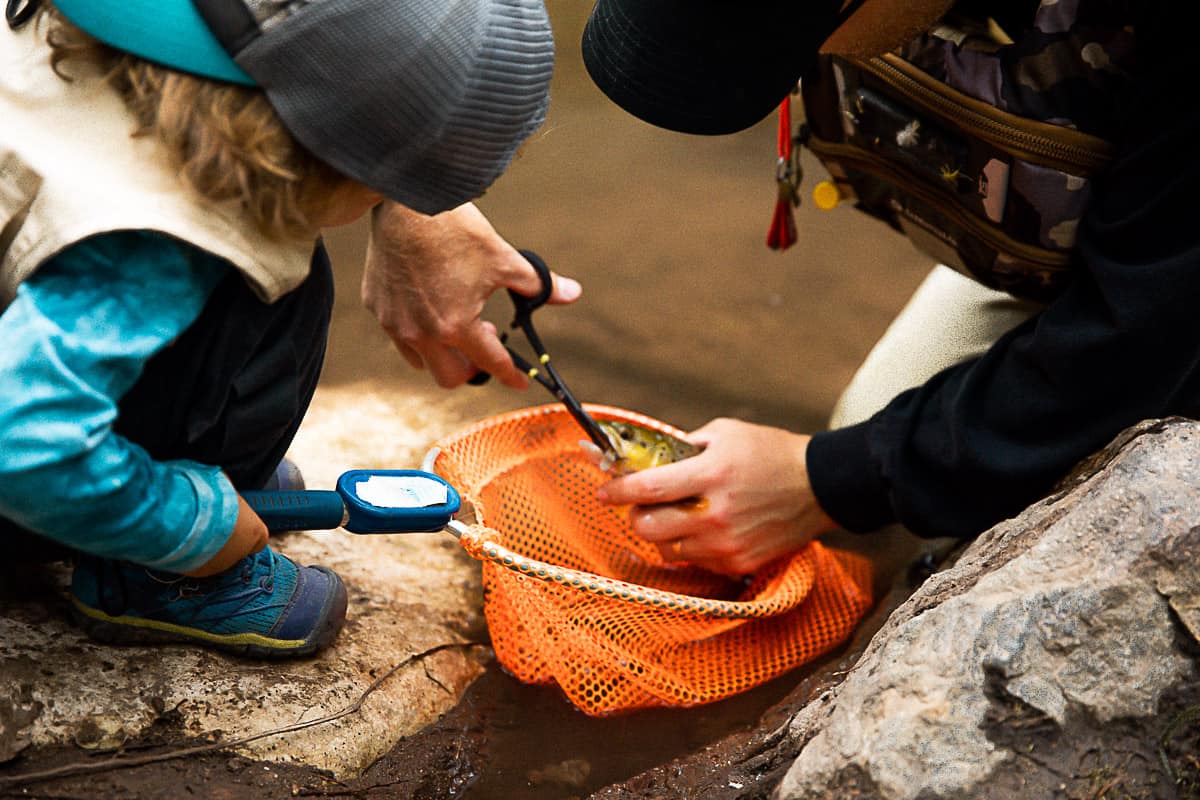
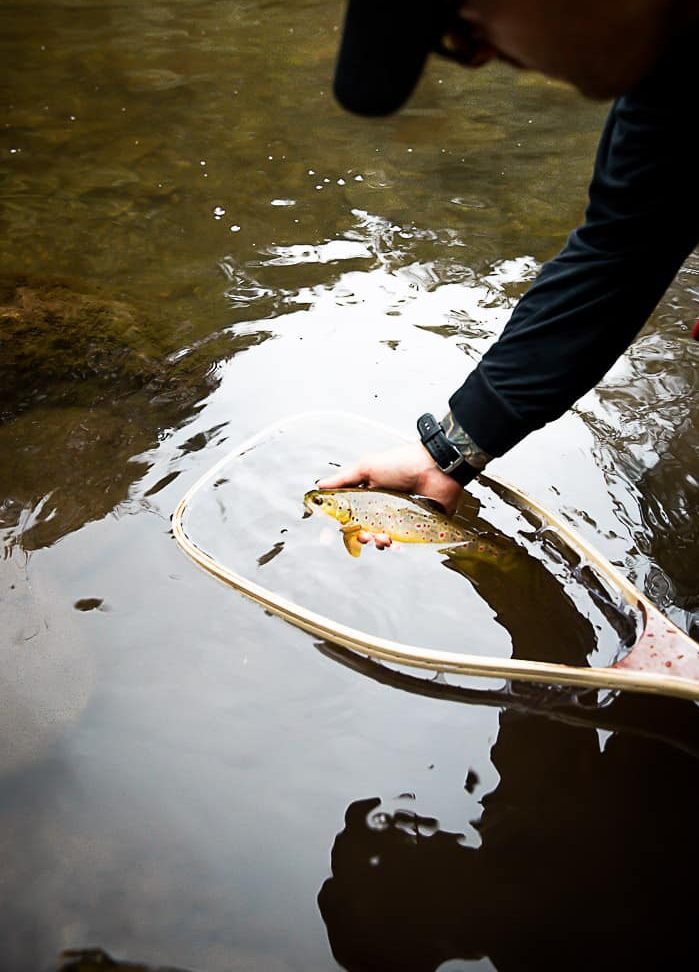
Fly fishing fish species
You can pretty much fly fish for any kind of fish: bass, catfish, saltwater fish, bluegill, trout, carp, etc. All of the tips above can be applied to any kind of fish.
My family and I fly fish for trout only. Today, I will describe the different species of trout native to New Mexico. Trout are our favorite type of fish, not only for their beautiful colors and patterns, but their deliciousness! Who doesn’t love some fish tacos?
Trout can be native to your location or stocked by local farms or conservation departments. Trout love cold water, so they’re more prevalent in cold-water streams. There are many different varieties of trout and they look different. you can catch one or multiple types based on your location.
We love when we catch different species of trout in one location, and it’s even more enjoyable teaching our kiddo the different names. We let him hold the fish and show him the different patterns and colors. He has learned how to gently hold a fish and even release it back into the water properly. Kids learn to love what they can touch, feel and experience. Fly fishing has given him an amazing opportunity to do just that!
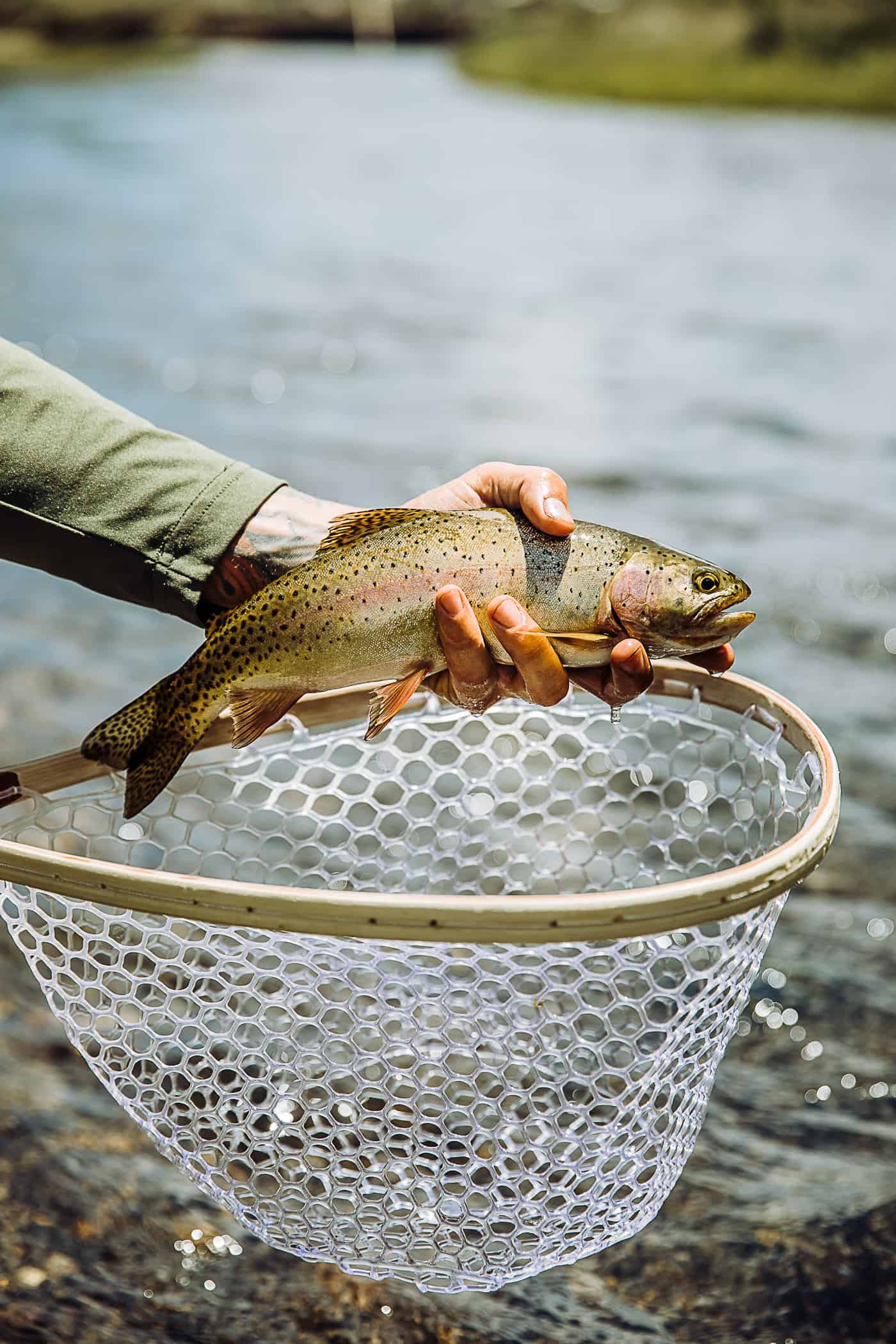
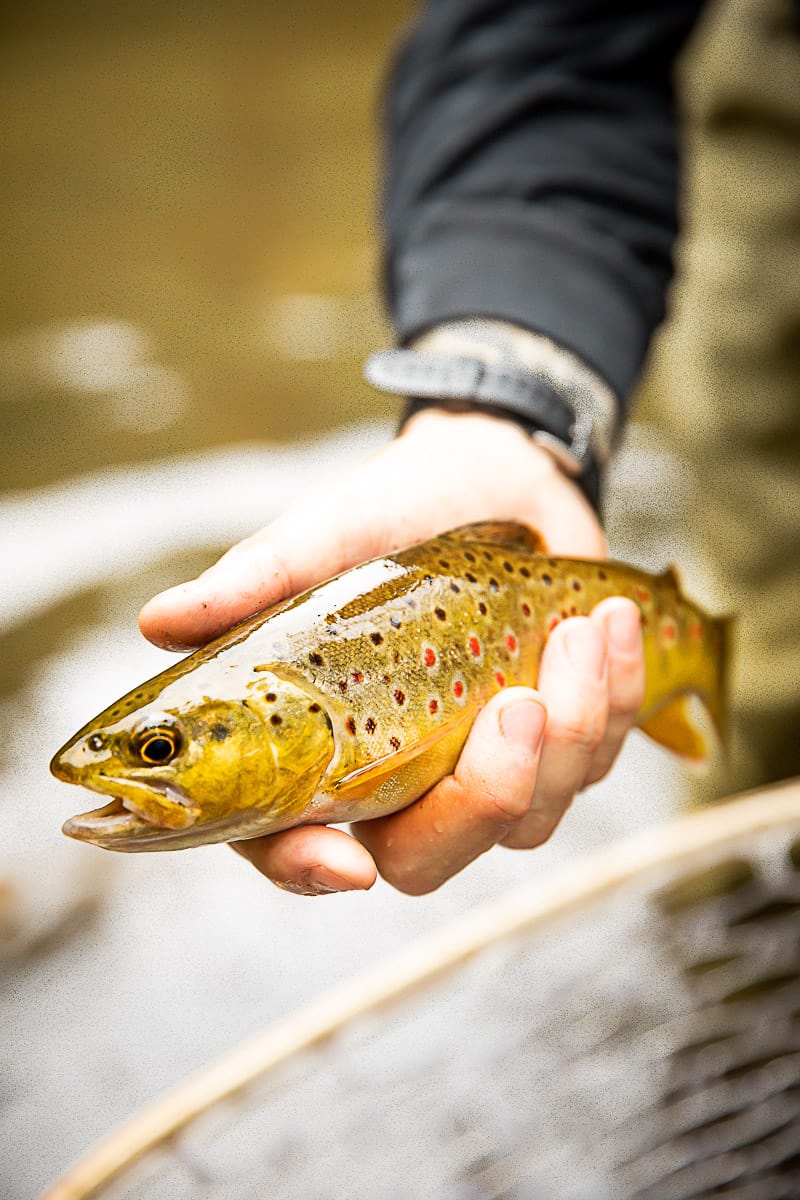
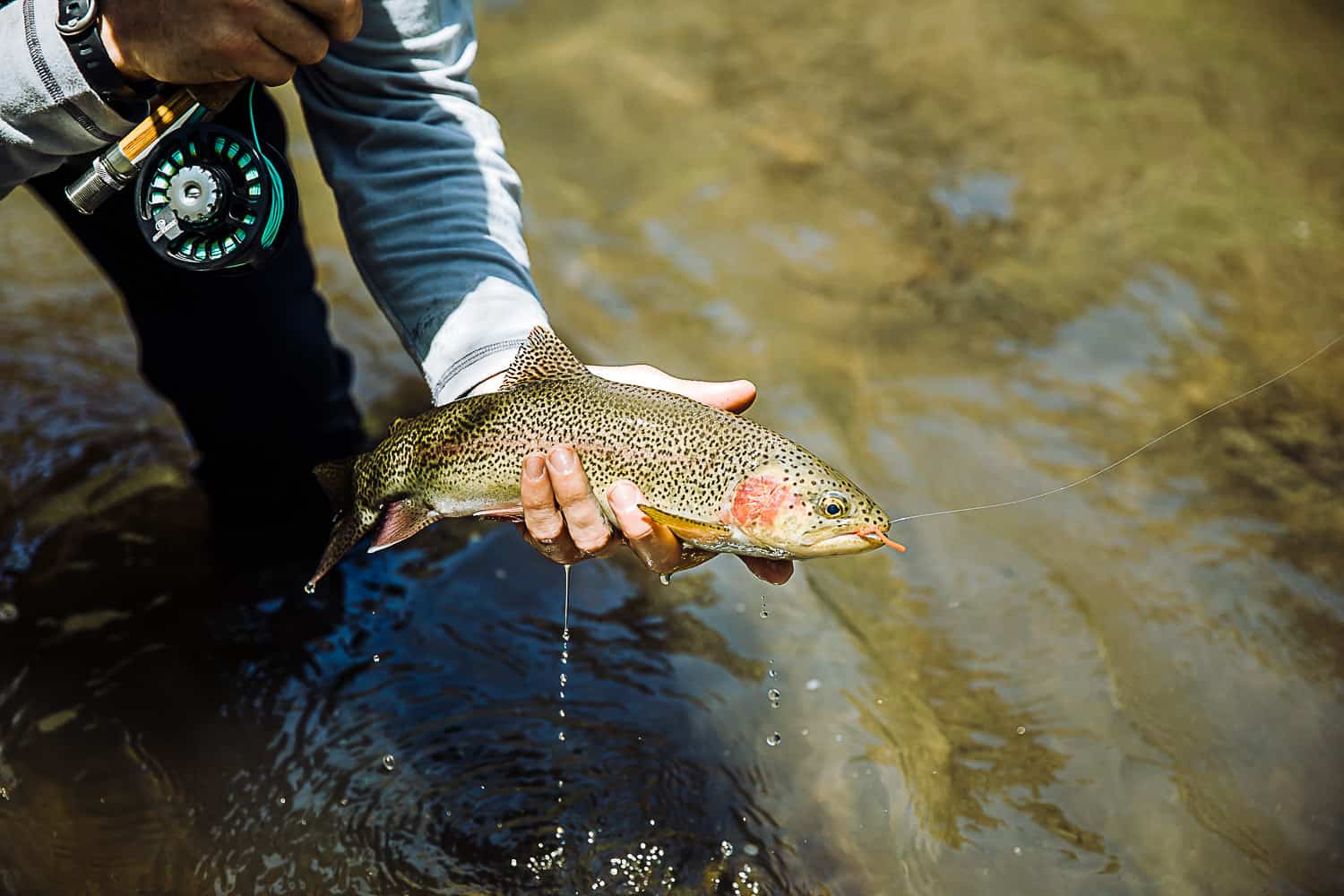
Trial and error/patience
Fly fishing is all about trial and error. It’s important to be patient when starting out and to teach our kids the same. Fly fishing can require us to try several different types of flies, casts, and sections of water until we find the right one. Knots happen. Tangles happen. Flies are lost. Somtimes you’ll spend more time untangling line than actually fishing. It’s all part of the process.
Fly fishing also requires a lot of moving, walking up and down the river, trying new spots and new shots. If your little one is too young to walk, consider a carrier or a backpack (we’ve used both). If your child’s old enough, you can practice cast with them every now and then.
Keep your fly fishing outings light-hearted with no pressure. When your kids start to get frustrated or super wiggly, stop and do something else. Working with young children on casting basics and letting them experience catching fish on a fly rod are great at any age. The most important thing is to make it fun so they don’t get frustrated and completely give up before they’re patient enough to really enjoy it.
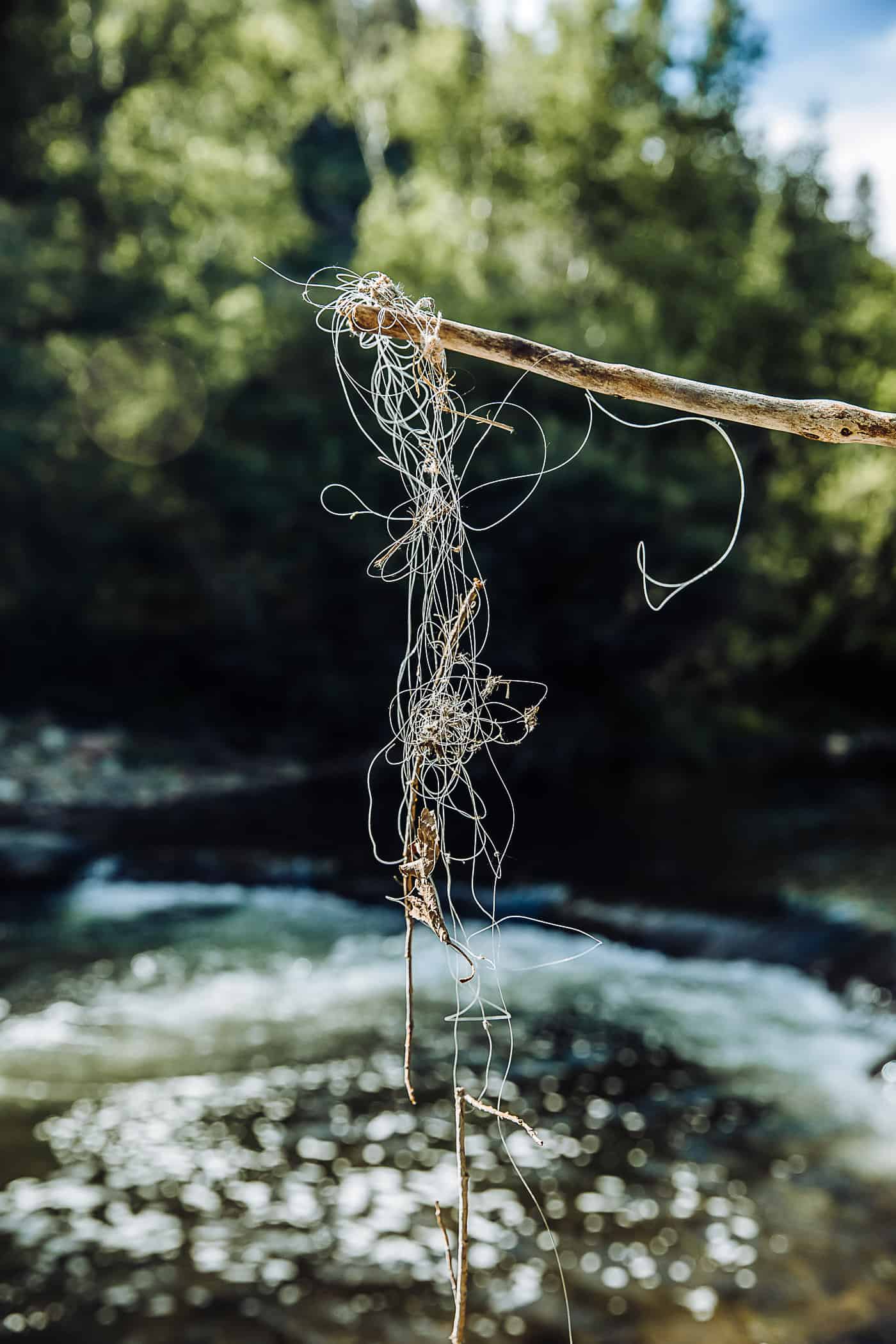
Leave no trace
Fishing is so much fun, especially when our kids’ eyes grow wide in amazement and they learn to love the sport. It’s important we teach our kids how to protect the fish and rivers. This is all starts with leaving no trace. Teaching our kiddos the importance of “pack out what you pack in”, cleaning up trash, and leaving the wild, wild.
Fishing with your kids is an incredible way to teach them about nature and conservation. From the “circle of life” lesson that comes with using live bait to the “leave no trace” principle of cleaning up after people, fishing is a way that parents can instill a love of nature and a respect for the environment from a very early age. There are so many little ways to encourage your kids to appreciate the outdoors through fishing. Whether it’s by respecting the fish you catch (and keeping only what you’ll eat) to respecting the fish’s habitat. Teaching your kids to fish helps preserve our natural resources.
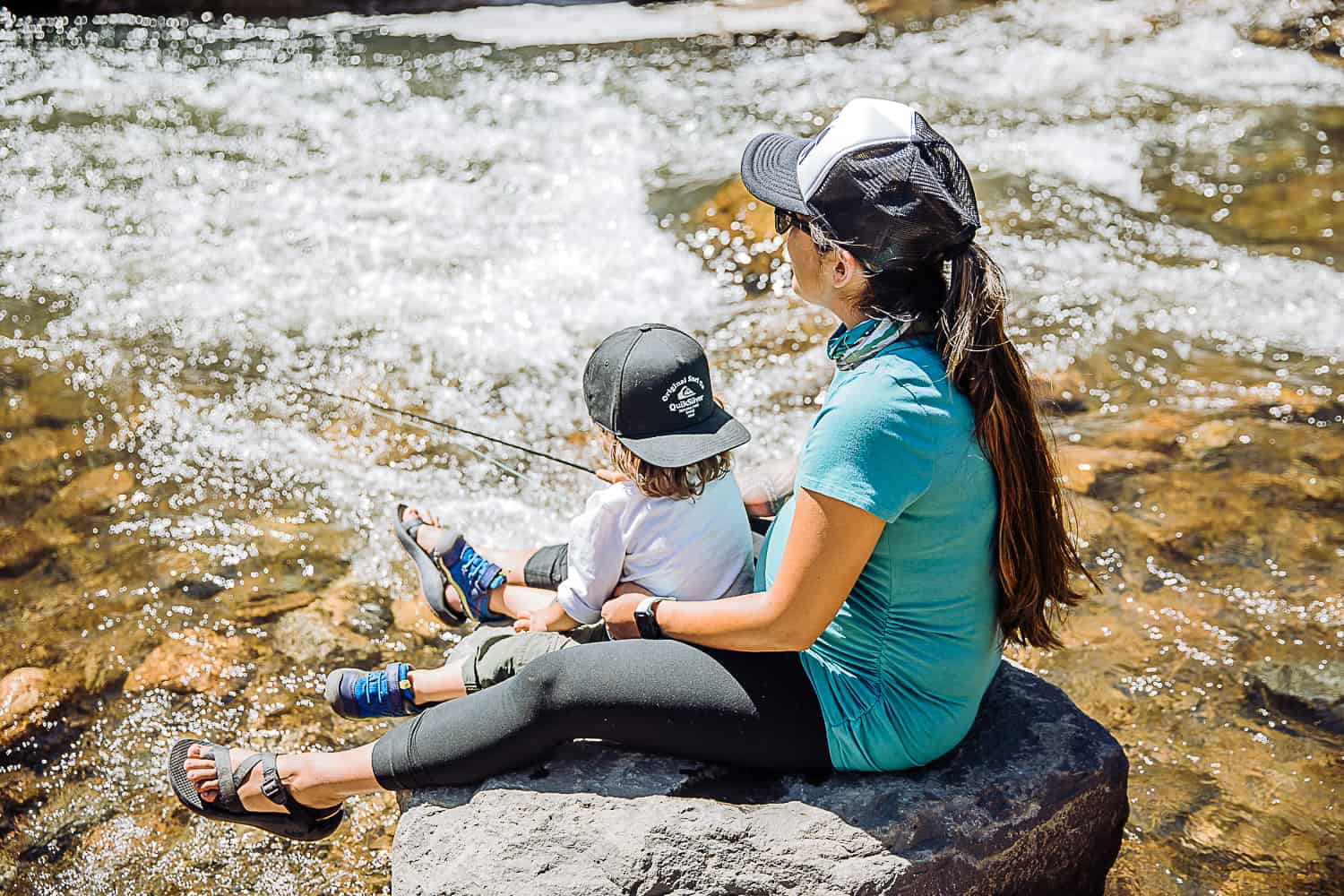


For more fish fun
If you’re interested in learning more about fishing with kids, be sure to check out a few of our other posts:
- Raising Kids that Love to Fish
- Fly Fishing with Kids
- Winter Crabbing with Kids
- Fly Fishing Location: Dry Run Creek, Arkansas
Have you ever taking your kids fly fishing?

About the author
Lea is a dedicated wife, adventurous mother, Registered Nurse, and Army veteran. She is from New Mexico and strives each and every day to get outside with her wild toddler and newborn baby girl. She and her husband Brandon both served 8 years in the Army and it was during that time their love for the outdoors and seeing the world was born. When they had their son, that passion only intensified. They love to fly fish, overland in their Jeep, hike, surf, and capture these moments on camera. Lea is a professional photographer on the side and you can always catch her with her camera in her hand. Their goal is to influence more families in their rural state of New Mexico to explore the beauty of the SW while educating them on photography tips, medical tips like First Aid, and outdoor safety and gear, etc.
You can find Lea online in the following locations:
Instagram: @wildstokefam
Website: Wild Stoke Fam
RWMC posts: Lea
Comments
2 responses to “Fly Fishing 101: Fly Fishing Basics for Kids”
nice post
[…] Kids learn to read the water, understand fish behavior, and adapt their techniques accordingly. These skills can translate into other areas of life, promoting problem-solving abilities and […]

Leave a Reply